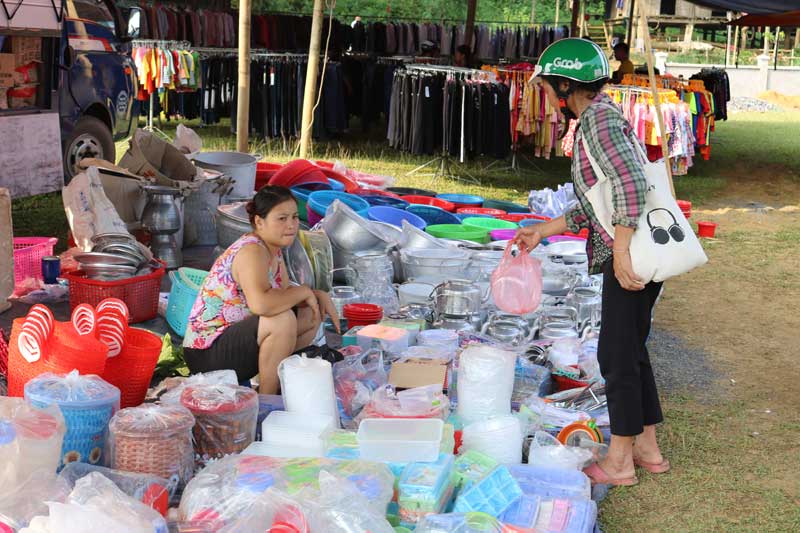
(HBO) - For a long time, Lo Son fair has become an indispensable cultural feature of the people in Lo Son commune (Tan Lac) and the neighboring communes. In addition to the purpose of buying, selling and exchanging the local products, the fair is held twice a week and is a place where the gentle, friendly and naive Muong people meet each other.
About 20 km far from the center of Tan Lac district, Lo Son
is a remote commune with the difficult economic conditions of the district. To
get to the fair, people are busy preparing when it is dawn, the night dew is
still on the leaves and the grass and the sun is still deep in the mountain.
Following the trails on the mountainside, the main road is paved with asphalt
to the vacant land in the center of the commune. From the early morning, Lo Son
fair is crowded with people.
Lo Son commune fair (Tan Lac) is an opportunity for the
people in the commune and the neighboring ones to trade, meet and exchange.
The commune’s fair is filled with the local culture. People
bring there the things that the family can produce by themselves or raise or
collect in the forests such as bamboo shoots, forest vegetables, Doi seeds,
pigs, chickens and also the cakes often called "Husband-wife cake”, a traditional
cake of Muong ethnic people. The fair is also an opportunity for small
businesses to bring goods such as hoes, shovels, knives, blankets, mats,
pillows, curtains, household items ...from the plains to serve the needs of the
mountainous people.
People going to the market are very diverse. They are those
of all ages, from the baby chasing the mother to the elderly with the cuffed
back, the gray hair and the mouth chewing the betel-nut. Although the fair is
very bustling, it seems that they rarely charge high prices for an item and the
buyer never gives the item back. As they consider it as an exchange item to get
to know each other, the seller does not charge high prices, the buyer does not
pay for the price. Goods displayed are also extremely simple. Sometimes, they
are displayed on banana leaves, sacks, raincoats, tarpaulins or in baskets,
pots ... The kiosks are also set up simply.They use bamboo, cork, corrugated iron or covered roof ...
Lo Son fair is a miniature picture, showing the traditional
culture of Muong ethnic people in Lo Son commune and the neighboring communes.
Although life is growing day by day, the fair still remains a distinct culture
making a good impression for those who come there once. It makes them remember
and love the land of gratitude.
With an increasingly vibrant and widespread emulation movement aimed at building cultured residential areas and cultured families, Yen Thuy District has been making steady progress toward improving both the material and spiritual well-being of its people, while fostering a civilized, prosperous, beautiful, and progressive community.
Once lacking recreational spaces and community facilities, Residential Group 2 in Quynh Lam Ward (Hoa Binh City) has recently received attention for the construction of a new, spacious, and fully equipped cultural house. The project followed the model of state support combined with public contributions in both labor and funding.
The "All people unite to build cultural life" movement, which has been effectively integrated with Kim Boi district’s socio-economic development goals, is fostering a lively spirit of emulation across local residential areas, hamlets, villages, public agencies, and enterprises. In addition, through the initiative, traditional cultural values are being preserved and promoted, while community solidarity and mutual support in poverty reduction and economic development are being strengthened.
A working delegation of the Hoa Binh provincial People’s Committee led by its Permanent Vice Chairman Nguyen Van Toan on June 11 inspected the progress of a project to build the Mo Muong Cultural Heritage Conservation Space linked to tourism services in Hop Phong commune, Cao Phong district.
Born and growing in the heroic land of Muong Dong, Dinh Thi Kieu Dung, a resident in Bo town of Kim Boi district, in her childhood was nurtured by the sweet lullabies of her grandmother and mother. These melodies deeply imprinted on her soul, becoming an inseparable part of her love for her ethnic group's culture. For over 20 years, this love for her hometown has driven Dung to research, collect, and pass down the cultural values of the Muong people to future generations.
In the final days of May, the Ethnic Art Troupe of Hoa Binh Province organized performances to serve the people in remote, mountainous, and particularly disadvantaged areas within the province. These were not just ordinary artistic shows, but they were the meaningful journeys aimed at spreading cultural values, enhancing the spiritual life of the people and contributing to the preservation of ethnic minority cultural identities.



